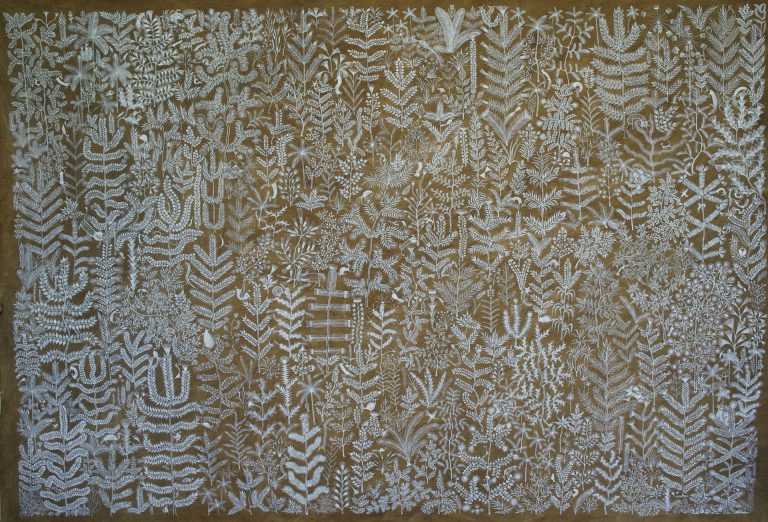We acknowledge the Traditional Owners of the land on which the Queensland Art Gallery | Gallery of Modern Art stands and recognise the creative contribution First Australians make to the art and culture of this country.

Mayur Vayeda / Warli people / India b.1992 / Tushar Vayeda / Warli people / India b.1987 / Dhartari: The creation of the world (detail) 2021 / Water-based colour and cow dung on cloth / 18 parts: 148 x 3162cm (overall) / Commissioned for APT10. Purchased 2021 with funds from Ashby Utting Foundation through the QAGOMA Foundation / Collection: QAGOMA / © Mayur Vayeda and Tashur Vayeda
Mayur and Tushar VayedaDhartari: The creation of the world 2021
Not Currently on Display
Mayur and Tushar Vayeda recount the story illustrated in their painting series:
‘Dhartari: The creation of the world’ is one of the old myths and part of Warli folklore. Warli beliefs are mainly connected with nature. We believe we came from one source of energy from the universe. This folklore is about the creation and recreation of the universe and dhartari (the Earth).
First, in the deep darkness, Mahadeva and Ganga-Gauri created themselves as the main source of energy, after which they created the universe. To create a better place, they created some other gods from the same energy source. These included the gods of thunder (Vijesar), clouds (Dhagesar), Sun (Suresar) and Moon (Chandesar). They gave them each different responsibilities and kingdoms to rule. However, the new gods betrayed and disobeyed Mahadeva’s orders, and so Mahadeva destroyed all their kingdoms.
Mahedeva then decided to recreate the universe but this time with the Earth. Mahadeva and Ganga-Gauri created the Earth with the help of different gods and goddesses and, to give birth to the planet, Ganga-Gauri spread all the seeds of the different lifeforms. Finally, in the end, they created humans. However, they had only created birth on the dhartari. There was no death. Creatures started growing and growing and dhartari started feeling the weight of all the lifeforms’ energies on her. She requested Mahadeva and Ganga-Gauri come up with a solution. Mahadeva then created death to create the cycle of life — in order to keep balance on Earth.
It wasn’t enough! So Mahadeva decided to create mahapralay (the flood) on dhartari to destroy what had been created, and for this he chose man, with the name ‘Pandu’. Mahadeva and Ganga-Gauri gave Pandu a seed of a water gourd (called taru in this story). They gave him instructions to grow taru for 100 years, and after 100 years Mahadev began the mahapralay to destroy life on the Earth. Pandu made a ship from taru and lived inside for several years with pairs of all the creatures and seeds from earth. All the other creatures died in the water, but when the taru finally touched land, life started again on the planet.1
Mayur and Tushar Vayeda are brothers who belong to the indigenous Warli people, living in their ancestral village of Ganjad in Maharashtra, India. Their practice is rooted in traditional Warli painting, a 5000-year-old art form that originated in cave painting. Varli, the Warli language, does not have a formal writing system, so painting pictures has long been considered the mode of writing and passing on knowledge. Warli paintings illustrate key aspects of folklore and life in Ganjad, and traditionally decorate the mud walls of village houses. Over the years, the Vayedas have adapted this style to create a new visual language that articulates their individuality and personal experiences. They have also experimented with translating the contents of traditional wall paintings to more accessible formats, such as paper, canvas, mural, and installation.
The Vayeda brothers’ recent painting projects document Warli narratives on an unprecedented scale and level of detail, translating them for new contexts and social conditions. In two series — ‘Dhartari: The creation of the world’ and ‘Disappearing spirits and childhood memories’ — they seek to share some of these important historical narratives and explain them in their own way.